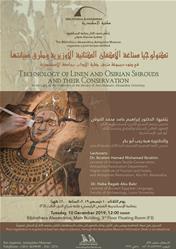The BA Organizes a Lecture on the Technology of Linen and Osirian Shrouds and their Conservation
Posted on

The BA Antiquities Museum, affiliated to the Cultural Outreach Sector, organizes a joint lecture entitled "Technology of Linen and Osirian Shrouds and their Conservation" on Tuesday, 10 December 2019; 12:00 noon at the Bibliotheca Alexandrina, Main Building, 3rd Floor Floating Room (F3). Dr. Ibrahim Hammed Mohamed Ibrahim, Lecturer of Antique Textile Conservation, Antiquities Restoration Department, Higher Institute of Tourism and Hotels, and Antiquities Restoration, Abu Kir, Alexandria, and Dr. Heba Ragab Abu Bakr, Lecturer of Ancient Egyptian Language, Faculty of Archaeology, Luxor University will deliver the lecture.
The lecture deals with linen shrouds, which are large rectangular linen textile that are sometimes placed on mummies, and sometimes around the body above the linen to cover the body tightly from head to foot. The shroud is held in place with specially woven laces, and is devoid of decoration or decorated with a life-size painting of the God Osir, either simplified by drawing the outer border or fully filled in with red or black ink. It was therefore called the Osirian shroud.
The texts accompanying the shroud represent spells or parts of the Book of the Dead using the red or black ink as well as the name of the deceased. It also represents the God by mentioning his titles, and texts of supplication from the deceased. It also includes the titles of the deceased himself. These texts aim to glorify the God by the deceased in the hope of gaining protection and blessing, and to seek intercession from the deity in the afterlife, as well as to assist the deceased during his journey to the underworld.
The study of the technical aspect used to create the linen shroud by ancient Egyptian weavers is very important, especially as it will be addressed not only from the point of view of historians who have always been interested in terms, definitions and descriptions, but also from the point of view of specialists in textile techniques.